|
Boletín de la Sociedad Geológica Mexicana Volumen 75, núm. 3, A080923, 2023 http://dx.doi.org/10.18268/BSGM2023v75n3a080923
|
 |
New taxa of cockroaches (Blattodea: Blattaria) from early Miocene amber of Chiapas, Mexico
Nuevas taxa de cucarachas (Blattodea: Blattaria) del ámbar del Mioceno temprano de Chiapas, México
Julio C. Estrada-Álvarez 1,2, Carlo G. Sormani2,3, Reinier Núñez-Bazán2,4, Jorge A. Mata-González1, Francisco J. Vega5,*
1 Museo Universitario de Historia Natural Dr. Manuel M. Villada UAEMex, Instituto Literario 100, Colonia Centro, 50000, Toluca, Estado de México, Mexico.
2 Entomological Research, Metepec, Bo. San Mateo, Estado de México, México.
3 Instituto de Ecología, A.C., Ap. Postal 63, 91000, Xalapa, Veracruz, Mexico.
4 Centro de Investigación en Biodiversidad y Conservación (CIByC), Universidad Autónoma del Estado de Morelos, Morelos, Mexico.
5 Instituto de Geología, Universidad Nacional Autónoma de México, Ciudad Universitaria, Coyoacán, 04510, CDMX Mexico.
* Corresponding author: (F.J.Vega) This email address is being protected from spambots. You need JavaScript enabled to view it.
How to cite this article:
Estrada-Álvarez, J.C., Sormani, C.G., Núñez-Bazán, R., Mata-González, J.A., Vega, F.J., 2023, New taxa of cockroaches (Blattodea: Blattaria) from early Miocene amber of Chiapas, Mexico: Boletín de la Sociedad Geológica Mexicana, 75 (3), A080923. http://dx.doi.org/10.18268/BSGM2023v75n3a080923
Manuscript received: June 14, 2023; Corrected manuscript received: September 7, 2023; Manuscript accepted: September 9, 2023.
ABSTRACT
Twelve pieces of amber containing the remains of cockroaches are used to form the basis of this paper. Gutierrezina vrsanskyi n. gen., n. sp., is described. Supella miocenica Cifuentes-Ruiz, Vidlička, Čiampor and Vega, 2011 is moved to the new genus Gutierrezina. Three new species are described for the genus Cariblatta Hebard, 1916: C. simojovelensis n. sp.; C. amfivola n. sp.; and C. uchbena n. sp. In addition, new information from Anaplecta vega Barna et al. 2019 and Latiblattella sp. is provided.
Keywords: fossil, Simojovel amber, new taxa, new combination.
RESUMEN
Doce piezas de ámbar que contienen restos de cucarachas constituyen la base de este trabajo. Gutierrezina vrsanskyi n. gen., n. sp., es descrita. Supella miocenica Cifuentes-Ruiz, Vidlička, Čiampor and Vega, 2011 es transferida al nuevo género Gutierrezina. Tres nuevas especies son descritas para el género Cariblatta Hebard, 1916: C. simojovelensis n. sp., C. amfivola n. sp. y C. uchbena n. sp. Adicionalmente, nueva información de Anaplecta vega Barna et al. 2019 y Latiblattella sp es proporcionada.
Palabras clave: fósil, ámbar de Simojovel, nuevos taxa, nueva combinación.
- Introduction
The amber from Chiapas has been considered as late Oligocene-middle Miocene in age (Frost and Langenheim, 1974; Solórzano-Kraemer, 2007, 2010). However, based on isotopic data and mollusk biostratigraphy, an early Miocene age (23 Ma) for the basal Campo La Granja amber (La Quinta Formation, Finca Carmitto Member) and the overlying Mazantic Shale (Vega et al., 2009; Perrilliat et al., 2010) has been interpreted. Serrano-Sánchez et al. (2016) supported this interpretation with nannoplankton biostratigraphy, and discussed the differences of paleoenvironments between the Campo La Granja and the Mazantic Shale ambers, based on the evident estuarine tidal influence found in pieces of the stratified amber from Campo La Granja (along with its contents of estuarine microcrustaceans), compared with the more terrestrial amber from mines of the Mazantic Shale, from which the pieces with insects here described were collected, polished, observed and photographed for their proper description. Location maps, stratigraphy and paleoenvironmental discussion is found in Serrano-Sánchez et al. (2016).
The early Miocene amber from Chiapas (Simojovelita sensu Riquelme et al. 2014, 2016) with preserved cockroaches is well represented the first reference of this is found in Hurd et al. (1962), where he presents a compilation of the biological inclusions of Mexican amber, an important contribution in this regard appears in Solórzano-Kraemer (2007), which reviews the three largest collections of Mexican amber with biological inclusions. Solórzano-Kraemer (2007) demonstrate the exceptional paleo-biological diversity of Chiapas amber. The first species described from Mexican amber was Supella miocenica Vršanský, Cifuentes-Ruiz, Vidlička, Čiampor and Vega, 2011, from Los Pocitos mine, Simojovel de Allende, Chiapas (lower Miocene). Estrada-Álvarez (2017) presented a chronology of the most important works regarding cockroaches included in amber from Chiapas. In addition they presented a paleo-taxonomic catalog and list of institutions with Mexican amber with cockroaches included. Barna et al. (2019) described the second formal Mexican species in Mexican amber, Anaplecta vega Barna, Smídová and Coutiño, 2019.
- Materials and Methods
Twelve pieces of amber with preserved cockroaches from the Mazantic Shale (lower Miocene) collected in mines nearby Simojovel de Allende, Chiapas were observed. Each piece was reviewed under a stereoscope using different magnifications, obtaining digital images.
The general classification follows Beccaloni (2014), Beccaloni and Eggleton (2011, 2013) with modifications by Djernæs et al. (2020).
The specimens were compared with material from the following collections: Laboratorio de Ecología y Sistemática de Microartrópodos, Facultad de Ciencias, Universidad Nacional Autónoma de México, Mexico City, Mexico (LESM); Muséum d’histoire naturelle de Genève, Genève, Suisse (MHNG); Instituto de Ecología. Xalapa, Veracruz, México (IEXA); Colección Entomológica, Entomological Research A.C., Metepec, Estado de México, Mexico (CER); Colección Nacional de Insectos, Instituto de Biología, Universidad Nacional Autónoma de México, Mexico City, Mexico (CNIN) (see other material revised).
The amber pieces with the biological inclusions here described are deposited at the Museo de Paleontología “Eliseo Palacios Aguilera”, Secretaría de Medio Ambiente e Historia Natural, Estado de Chiapas, Tuxtla Gutiérrez, Chiapas, Mexico, under acronym IHNFG.
- Results
Systematic palaeontology
Order Blattodea Brunner von Wattenwyl, 1882
Family Pseudophyllodromiidae Hebard, 1929
Genus Gutierrezina Estrada-Álvarez, Sormani and Núñez-Bazán n. gen.
Type species: Gutierrezina vrsanskyi Estrada-Álvarez, Sormani and Núñez-Bazán n. sp.
Diagnosis: Male subgenital plate with subspherical styles, without apical supination; absence of sexual dimorphism, male and females very similar.
Etymology: In honor of the great Cuban researcher and friend Dr. Esteban Gutiérrez Cubría, Museo Nacional de Historia Natural de La Habana, Cuba.
Description: Medium-sized (10-10.5 mm length). Sexual dimorphism absent, both sexes similar in development of well-developed tegmina. Coloration with pronotum highlighting a central macula and another on the posterior edge; tegmina with a longitudinally squiggly band. Femur I with spination type B2. Male with subgenital plate with projecting and bulging inter-stylar space, finger-like styles and without apical spines (Figure 2b). Female with subgenital lamina curved and complete.
Species included: Gutierrezina vrsanskyi Estrada-Álvarez, Sormani and Núñez-Bazán n. sp. and Gutierrezina miocenica (Vršanský Cifuentes-Ruiz, Vidlička, Čiampor and Vega, 2011) n. comb.
Gutierrezina vrsanskyi Estrada-Álvarez, Sormani and Núñez-Bazán n. sp.
(Figures1a, 1b; 2a, 2b)
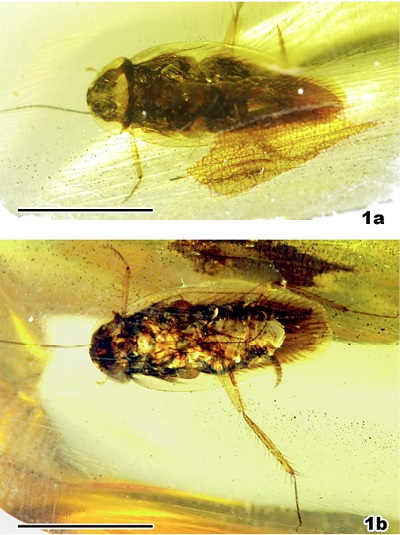 |
| Figure 1. Gutierrezina vrsanskyi Estrada-Álvarez, Sormani and Núñez-Bazán sp. n. Holotype male. (a) Dorsal habitus; (b) Ventral habitus. |
Type material: Complete male adult, unfolded hind wings, legs retracted, left leg exempt (Holotype IHNFG-6138).
Type locality and horizon: Simojovel de Allende, Mazantic Shale, lower Miocene (23 Ma).
Diagnosis: Pattern coloration of pronotum with the central macules extended posteriorly to join the posterior macule (Figures 1a, 2a), and sinuous tergine macula (Figure 1a).
 |
| Figure 2. Gutierrezina vrsanskyi Estrada-Álvarez, Sormani and Núñez-Bazán sp. n. Holotype male. (a) Pronotum; (b) subgenital plate. |
Etymology: In honor to Dr. Peter Vršanský (Institute of Zoology, Slovak Academy of Sciences) for his extensive contributions to the knowledge of fossil cockroaches.
Description: 10.5 mm overall length, 4 mm maximum width, overall body length (without wings) about 8 mm. Glabrous appearance. Tegmina and wings fully developed (Figure 1a). Pronotum (about 2 mm long, 3 mm wide) glabrous, sub-parabolic, anterior edge recurved and posterior edge, less curved; disc with two dark spots from the rear margin to the center, being wider at the front, posterior margin with transverse black macula (Figure 2a). Tegmina (forewing) (about 7.5 mm long, 2.5 mm wide) glabrous, without considerable deformation, longitudinal sinuous dark macula in the central part, venation simple, without being able to appreciate more details (Figure 1a). Hind wing not visible. Head (about 1.5 mm long, 1 mm wide), very deformed, distance between eyes (front) 0.4 mm, distance between antennal insertions 0.6 mm; antennae long, filiform, exceeding total length (about 15 mm long), ocelli inconspicuous, palps thin. Body relatively slender (about 4 mm long, 2 mm wide), segments (tergites and sternites) half anterior slightly wider. Supra-anal plate not visible Subgenital plate symmetrical and convex, styles very shorts, interestilar edge specialized (Figure 2b). Legs: I Femur (about 1.5 mm long) antero-ventral margin not visible, tibia (about 2 mm long) with 17 spines, tarsus (1.6 mm long [0.8+0.3+0.2+0.3]); II Femur (about 1.6 mm long), tibia (about 1.2 mm long) with 9 spines, tarsus (1.8 mm long [1+0.3+0.2+0.3]); III Femur (about 2 mm long), tibia (about 31 mm long) with 23 spines, tarsus (mm long [1.2+0.4+0.3+0.4]), pulvillus inconspicuous, arolium 50% the length of the tarsal claws, tarsal claws simples and symmetrical in the three legs.
Gutierrezina miocenica (Vršanský, Cifuentes-Ruiz, Vidlička, Čiampor and Vega, 2011) n. comb.
(Figures 3a-c)
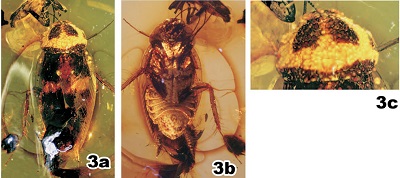 |
| Figure 3. Gutierrezina miocenica (Vršanský, Cifuentes-Ruiz, Vidlička, Čiampor and Vega, 2011) comb. n. (a) Dorsal habitus; (b) Ventral habitus; (c) Pronotum. |
Periplaneta [sp] in: Cifuentes-Ruiz y Vega, 2008: 929 [Det. Vrsansky].
Supella (Nemosupella) miocenica Vršanský et al., 2011: 466; fig. 2a-c, 3a-d. [sp. n.]
(Pseudophyllodromiinae). Behrensmeyer and Turner, 2013 (Pseudophyllodromiinae). Estrada-Álvarez, 2017: 56.
[Blattodea] in: Vršanský, 2011; [an unnumbered figure].
Supella miocenica Vršanský et al. in: Estrada-Álvarez, 2013: 280. Greenwalt and Vidlička, 2015:2 (Pseudophyllodromiinae).
Redescription: Body length (without wings) about 9 mm. glabrous appearance. Tegmina and wings fully developed (Figure 3a). Pronotum glabrous, sub-parabolic, anterior edge recurved and posterior edge, less curved; disc two well-separated macules, confined to the center (Figure 3c). Tegmina (forewing) glabrous, without considerable deformation, longitudinal dark macula in the central part in two parts, loosely connected (Figure 3a). Hind wing not visible. Body relatively wide sternites constrained half anterior. Supra-anal plate not visible. Subgenital plate symmetrical and convex (Figure 3b). Femur I with supination type B2; pulvilli present only on the fourth tarsomere, tarsal claws symmetrical and simple, arolia present.
Genus Cariblatta Hebard, 1916
Cariblatta Hebard, 1916: 147.
Type species: Cariblatta delicatula (Guérin-Méneville, 1857) [Cariblatta punctulata (Palisot de Beauvois, 1818) sin.jun. [=Blatta punctulata]]; by original designation.
Cariblatta simojovelensis Estrada-Álvarez, Sormani and Núñez-Bazán n. sp.
(Figures 4a-d)
Type material: Complete male adult, except for apex of tegminae and wings, incomplete pronotum for lack of polishing (Holotype IHNFG-6139). Complete female adult (Paratype IHNFG-6140).
Type locality and horizon: Simojovel de Allende, Mazantic Shale, lower Miocene (23 Ma).
Diagnosis: The morphology of the male sub-genital plate with modified and thorny styles having wider space between styles (Figure 4b).
Etymology: In reference of Simojovel town, Chiapas.
Description holotype: 11 mm overall length, 4 mm maximum width, overall body length without wings about 9.5 mm. Tegmina and wings fully developed. Coloration predominantly yellow, with distinctive blackish pronotum pattern. Pronotum (about 2.5 mm long, 2.3 mm wide) sub-parabolic, anterior edge recurved and posterior edge straight; disc with dark spots (Figure 4a). Tegmina (Forewing) (about 9-11 mm long, 3 mm wide) typical of the genus, incomplete right tegmina due to lack of polishing (Figure 4a). Hind wing not visible. Head (about 1.5 mm long, 2 mm wide), distance between eyes (front) 0.35mm, distance between antennal insertions 0.6 mm; 0.5, antennae long, longer than the body, ocelli inconspicuous, long palps. Body relatively slender, tergal structures not visible by wings and tegminae. Supra-anal plate not visible. Subgenital plate symmetrical, styles short and modified, inter-stylar edge ample (Figure 4b). Legs: I Femur antero-ventral margin with supination type B2 (sensu Roth); tibia with 9 long spines; II Femur with one genicular spine, tibia 14 long spines; III Femur with one genicular spine, tibia 21 long spines. Pulvillus inconspicuous, arolium 33% the length of the tarsal claws, tarsal claws simples, symmetrical and long claws in the three legs.
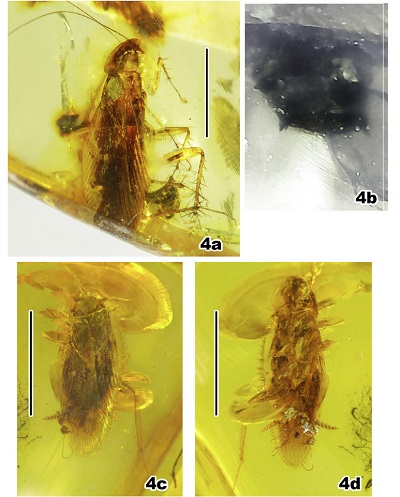 |
| Figure 4. Cariblatta simojovelensis Estrada-Álvarez, Sormani and Núñez-Bazán sp. n. (a, b) Holotype male, (a) Dorsal habitus; (b) Detail of subgenital plate. (c, d) Paratype female, (c) Dorsal habitus; (d) Ventral habitus. |
Paratype (female) (Figure 4c, 4d): 9 mm overall length, 3 mm maximum width, overall body length without wings about 7.5 mm. Tegmina and wings fully developed. Coloration predominantly yellow, similar to male. Pronotum (about 2.6 mm long, 2.5 mm wide) distorted (Figure 4c). Tegmina (Forewing) (about 7-7.3 mm long, 1.3 mm wide) typical of the genus (Figure 4c). Hind wing not visible. Head (about 1.3 mm long, 1.5 mm wide), very distorted, distance between eyes (front) (?), distance between antennal insertions, antennae (Figure 4c). Body relatively slender (Figure 4c). Supra-anal plate not visible. Subgenital plate not visible by an ant (Formicidae) (Figure 4d). Legs: similar to male.
Cariblatta amfivola Estrada-Álvarez, Sormani and Núñez-Bazán n. sp.
(Figures 5a-5e)
Type material: Complete female adult (Holotype IHNFG-6141). Complete female adult (Paratype I IHNFG-6142). Complete female adult (Paratype IHNFG-6143).
Other material revised: Complete juvenile (IHNFG IHNFG-6144) (Figure 5c).
Type locality and horizon: Simojovel de Allende, Mazantic Shale, lower Miocene (23 Ma).
Diagnosis: Differing in wider macula in pronotum (Figures 5a, 5d, 5e).
Etymology: From the Greek word “αμφίβολος-amfívolos”, doubtful, that generates doubt from the variation in the color pattern of the pronotum.
 |
| Figure 5. Cariblatta amfivola Estrada-Álvarez, Sormani and Núñez-Bazán sp. n. (a) Holotype female, in dorsal habitus. (b) Paratype female, in dorsal habitus. (c) Nymph. (d) Paratype female, detail of pronotum; (e) Paratype female, detail of pronotum. |
Description of holotype (female): 8 mm overall length, 3.5 mm maximum width, overall body length without wings about 7 mm. Tegmina and wings fully developed. Coloration predominantly yellow, with blackish pronotum pattern. Pronotum (about 1.8 mm long, 2.4 mm wide) sub-parabolic, anterior edge recurved and posterior edge procurved; disc with dark spots and a black stripe on posterior edge (Figures 5a, 5b, 5d, 5e). Tegmina (forewing) (about 6.5 mm long, 2 mm wide) typical of the genus, small macule in discal area (Figure 5a). Hind wing not visible. Head (about 1.8 mm long, 1.8 mm wide), narrowing of the oral apparatus, prominent eyes, distance between eyes (front) 0.65 mm, distance between antennal insertions 0.6mm; antennae incomplete, ocelli inconspicuous, palps typical of the. Body relatively slender. Supra-anal plate not visible. Subgenital plate fragmented at the apex. Legs: I Femur (1.2mm) antero-ventral margin with supination type B2 (sensu Roth); tibia (2 mm) with 6 long spines, tarsus (1.5 mm); II Femur (1.5(?)) with one genicular spine, tibia (2 mm) 11 long spines, tarsus (1.5 mm); III Femur (2.3 mm) with one genicular spine, tibia (2.7 mm) 25 long spines, tarsus (2 mm). Pulvillus absent, arolium 20% the length of the tarsal claws, tarsal claws simples, symmetrical and very thin claws in the three legs.
Cariblatta uchbena Estrada-Álvarez, Sormani and Núñez-Bazán n. sp.
(Figures 6a-c)
Type Material: Complete male adult (Holotype IHNFG- IHNFG-6145).
Type locality and horizon: Simojovel de Allende, Mazantic Shale, lower Miocene (23 Ma).
Diagnosis: The morphology of the subgenital plate differing from it in the angles of the more angular lateral projections and smaller projection of the interstilar space.
Etymology: Using a Mayan word Úuchben, in Latin form, meaning ancient.
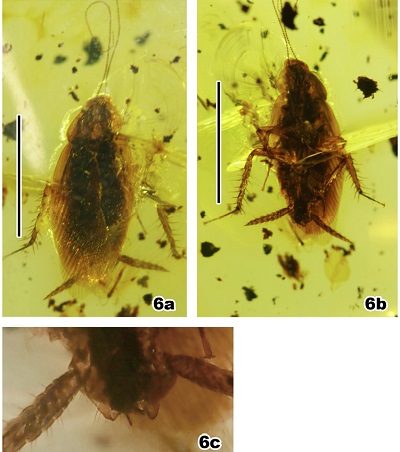 |
| Figure 6. Cariblatta uchbena Estrada-Álvarez, Sormani and Núñez-Bazán sp. n. Holotype male. (a) Dorsal habitus; (b) Ventral habitus; (c) subgenital plate. |
Description of holotype: 8.5 mm overall length, 3.5 mm maximum width, overall body length without wings about 7.4 mm. Tegmina and wings fully developed. Coloration predominantly yellow, with distinctive blackish pattern in pronotum and tegminae. Pronotum (about 2 mm long, 2.3 mm wide) sub-parabolic, anterior edge recurved and posterior edge procurved; black macula almost throughout the pronotal disc (Figure 6a). Tegmina (Forewing) (about 10-11 mm long, 3 mm wide) typical of the genus, darker than the other two species described above (Figure 6a). Hind wing protruding from the tegminae (Figure 6a). Head (about 1.3 mm long, 1.9 mm wide), distance between eyes (front) 0.3 mm, distance antennae long and long palps. Body relatively slender, tergal structures not visible by wings and tegminae. Supra-anal plate not visible. Subgenital plate symmetrical, styles not visible, interestilar edge ample (Figures 6b, 6c). Legs: I Femur antero-ventral margin with supination type B2 (sensu Roth); tibia with 8 long spines; II Femur with one genicular spine, tibia 10 spines; III Femur with one genicular spine, tibia 26 long spines. Pulvillus inconspicuous, arolium 20% the length of the tarsal claws, tarsal claws simples, symmetrical and long claws in the three legs.
Latiblattella sp.
(Figures 7a, b)
Material revised: Complete nymph (IHNFG-6146).
Locality and horizon: Simojovel de Allende, Mazantic Shale, lower Miocene (23 Ma).
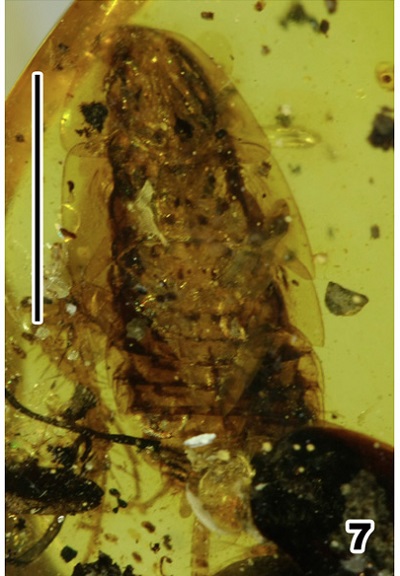 |
| Figure 7. Latiblattella sp. (a) Nymph in dorsal habitus; (b) Middle legs. |
Description (nymph): 10 mm overall length, 5 mm maximum width. Tegmina and wings absents. Coloration predominantly yellow, with distinctive blackish pattern in pronotum, mesonotum and metanotum. Pronotum (about 2.0 mm long, 3.1 mm wide) sub-parabolic, anterior edge recurved and posterior edge straight. Tegmina (forewing) absent. Hind absent. Body relatively robust, without tergal structures. Supra-anal plate not visible. Subgenital plate with posterior edge recurved. Legs: Femur I antero-ventral margin with supination type B2 (sensu Roth). Pulvillus in the four tarsemeres, arolium 60% the length of the tarsal claws; tarsal claws simples and asymmetrical (Figure 6b).
Anaplecta vega Barna, Šmídová and Coutiño, 2019
(Figures 8a-c)
Anaplecta sp. n. Barna, 2015: 61.
Anaplecta vega Barna, Šmídová and Coutiño 2019: 5; figs. 1A-D, 2A-C.
 |
| Figure 8. Anaplecta vega Barna, Šmídová and Coutiño, 2019. (a, b) Male in dorsal habitus; (c) Detail of genital hook. |
Revised material: Two complete adult males (IHNFG-6147; IHNFG-6148).
All caracters conform to Barna et al., 2019.
Other material revised: Euthlastoblatta orizabae (Saussure, 1868) Sintypes Mexique, Sumichhrast Coll. (MHNG). 2♀♀ La Mancha, Reserva Estatal CICOLMA. Pastizal Inducido. Trampa de Cebo, Plátano Fermentado; Mayo 2004; Sormani, H.C.G. and Ángeles, V.J.A. Colls. (IEXA). ♂, ♀, 6juv. La Mancha, Reserva Estatal CICOLMA. Selva Mediana Subcaducifolia. Manual; Octubre 2003; Sormani, H.C.G. and Ángeles, V.J.A. Colls. (IEXA). 1♂ La Mancha, Reserva Estatal CICOLMA. Pastizal Inducido. Trampa de Cebo; Octubre 2003; Sormani, H.C.G. and Ángeles, V.J.A. Colls. (IEXA). 2♀♀ La Mancha, Reserva Estatal CICOLMA. Pastizal Inducido. Trampa de Cebo, Plátano Fermentado; Mayo 2004; Sormani, H.C.G. and Ángeles, V.J.A. Colls. (IEXA). 10♂♂, 5♀♀ La Mancha, Reserva Estatal CICOLMA. Pastizal. Borde con Selva Mediana Subperenifolia. Trampa de Cebo, Plátano Fermentado; Mayo 2004; Sormani, H.C.G. and Ángeles, V.J.A. colls. (IEXA). Euthlastoblatta grata Hebard, 1922 1♂,1 Juv. México, Jalisco, Est. Biol. Chamela, Cuenca 4, Trampa Maisle; 19-12/VIII/1992; A. Rodriguez coll. (LESM). 1Juv. Est. Biol. Chamela? W-4A; Fumigación; 14/V/1993; Coll. Anonymous (LESM). 2♂♂ México, Jalisco, Est. Biol. Chamela, 19.4°98´14´´ N, 105.4°44´40´´ O alt. 95m, Trampa de luz; 23-VI-2009; H. Clebch, A. Zaldivar Colls. (CNIN). 1♂ México, Jalisco, Estación de Biología Chamela, cerca del Laboratorio 19.49858 N, 105.0442 W alt. 99m, Trampa de luz; 28-VII-2011; E. Maartinez Coll. (CNIN). Cariblatta sp. cer. C. hylaea Rehn, 1945. 2♂♂, 1♀ 4 juv. Bajo Grande, Cerro Espinazo. Selva Mediana Subcaducifolia. Trampas de Cebo; 17 octubre 2006; Soto, A.F. et al. Colls. (IEXA).
Anaplecta otomius Saussure, 1869. Holotipo ♀. Mexique; M. H de Saussure col. (MHNG).
Anaplecta mexicana Saussure, 1868. 4♂♂, 6 ♀♀ Sintypes R. Blanco, México; Sumicrast col. (MHNG). Anaplecta azteca Saussure, 1868. Holotype male Mexique, Orizaba; [Saussure?] col. (MHNG). Anaplecta nahua Saussure 1868. Holotype female Méxique, col. Anónimo (MHNG). Anaplecta tolteca Saussure, 1868. Holotype female Mexique; Sumicrast col. (MHNG). Anaplecta saussurei Hebard, 1921. 3♂♂ Adolfo López Mateos, Acahual, sobre suelo y Pitfall (LM21A); Enero 2003; Barois, I. et al. Cols. (IEXA). Latiblattella tarasca 5♂♂, 6♀♀ México, Estado de México, Metepec, Cerro de los Magueyes; ١٨/IX/٢٠١٨; J. C. Estrada-Álvarez and Balam Estrada F. Colls. (CER). Latiblattella kaupiana (Saussure, 1873). 1♂, 1♀. El Volcancillo-Toxtlacoaya. Pastizal Inducido. Trampa de Cebo; Mayo 2004 Sormani, H.C.G. and Ángeles, V.J.A. Colls. (IEXA).
- Discussion
Insects are one of the most diverse and abundant groups of animals found in Mexican amber (Solórzano-Kraemer, 2007) and that is the case for Simojovel amber inclusions. Cockroach fossils are poorly studied with about 80 described species worldwide (Beccaloni, 2014). For Mexico only two species have been previously described (Estrada-Álvarez, 2017). The specimens included in Simojovel amber show a strong relationship with the current fauna in the Americas. Gutierrezina Estrada-Álvarez, Sormani and Núñez-Bazán n. gen. from the current Mexican and Centro American fauna it resembles Euthlastoblatta Hebard, 1917, but differs in the finger-like styles, without apical supination (compared to apical spination in Euthlastoblatta; Gutiérrez in prep.), and the absence of sexual dimorphism (sub-cylindrical styles, with the spinous apex and sexual dimorphism in the development of the tegminae and posterior wings in Euthlastoblatta). The colour pattern of the pronotum and tegmina are similar to the genus Dendroblatta Rehn, 1916, but differ in having the symmetrical subgenital lamina and finger-like styles (asymmetric in Dendroblatta). Gutierrezina. vrsanskyi differs from G. miocenica n. comb. in the coloration pattern of pronotum and tegmina (Figure1b and 1f).
The observed diversity of the genus Cariblatta Hebard, apparently indicates great speciation in the Simojovel area 23 Ma ago. Current species of Cariblatta perch on leaves of various plants in tropical forests, closely related to vegetation in all stages of the life cycle. Presumably this genus speciated on this site of great prehistorical vegetation diversity. The morphology of the male sub-genital plate with modified and thorny styles in Cariblatta simojovelensis Estrada-Álvarez, Sormani and Núñez-Bazán n. sp., reminiscent of C. delicatula (Guérin-Méneville, 1857); it differs in having wider space between styles (Figure 4b). The pronotum in C. amfivola Estrada-Álvarez, Sormani and Núñez-Bazán n. sp.resemble Central American species C. hylaea Rehn, 1945 and C. icarus Rehn, 1945; differing in wider macula in pronotum (Figures 5a, 5d, 5e).
On the other hand, the abundance of specimens of A. vega included in these ambers probably indicates that this species was abundant in the area or closely related to the genus Hymenaea, which are the amber-forming plants responsible for the amber deposits in this area (Calvillo-Canadell et al., 2010; Avedaño-Gil et al., 2012; Poinar and Brown, 2002). Future discoveries of amber will help to understand the past diversity and evolution of Mexican cockroaches. Anaplecta vega share characteristics (small size 5 mm total length, beetle-shaped, with concave and sclerotic tegminal wings) with American species: Anaplecta saussurei Hebard, 1921 (♂) (México); A. asema Hebard, 1920 (♀) (Panama); A. brunneri Shelford, 1906 (?) (Brazil); A. cabimae Hebard, 1920 (♂) (Panama) and A maronensis Hebard, 1921 (♀) (Franch Guayana). 2) The genus Anapleta Burmeister, 1838 needs to be revised, the American species represent a great variety in forms and characteristics that warrant the establishment of new genera (Estrada-Álvarez and Sormani, in preparation).
Contributions of authors
Julio C. Estrada-Álvarez – Description of the taxa, photos and drafting. Carlo G. Sormani –Review of specimens and help with taxonomic determination. Reinier Núñez Bazán – Taxonomy review and English translation. Jorge A. Mata – Drafting and photo assistance. Francisco J. Vega – Contributed to the geology and financing amber pieces aquisition.
Financing
This research was solely funded by the authors.
Acknowledgements
Our sincere gratitude to Torrey Nyborg (Loma Linda University, USA) and María de Lourdes Serrano-Sánchez (Facultad de Ciencias, Universidad Nacional Autónoma de México) for their important suggestions to improve the original manuscript. Gerardo Carbot-Chanona helped with curation of specimens and locating amber pieces.
Conflicts of interest
We declare no conflict of interest.
References
Avendaño-Gil, J., Carbot-Chanona, G., Coutiño José, M.A., 2012, Estudio del ámbar con inclusiones biológicas de la Colección Paleontológica de la Secretaría de Medio Ambiente e Historia Natural: Lacandonia, (1), 23–29.
Barna, P., 2015, New species of Anaplecta Burmeister, 1838 (Blattaria) from Chiapas Amber, Mexico: Geology, Geophysics and Environment, 41(1), 61–62. https://doi.org/10.7494/geol.2015.41.1.61
Barna, P., Mídová, L., Coutiño, J.M., 2019, Living cockroach genus Anaplecta discovered in Chiapas amber (Blattaria: Ectobiidae: Anaplecta vega sp.n.). PeerJ 7: e7922. http://doi.org/10.7717/peerj.7922
Beccaloni, G.W., Eggleton, P., 2011, Order Blattodea Brunner von Wattenwyl, 1882, in Zhang, Z.Q., (Ed.), Animal biodiversity: An outline of higher-level classification and survey of taxonomic richness. Zootaxa, 3148 (1), 199–200.
https://doi.org/10.11646/zootaxa.3148.1.37
Beccaloni, G.W., Eggleton, P., 2013, Order Blattodea, in Zhang, Z.- Q. (Ed.), Animal biodiversity: an outline of higher-level classification and survey of taxonomic richness (addenda 2013). Zootaxa, 3703(1), 46–48.
https://doi.org/10.11646/zootaxa.3148.1.37
Beccaloni, G.W., 2014, Blattodea Species File Online. Version 1.2/4.0. World Wide Web electronic publication, available in: http://Blattodea.Species File.org
Behrensmeyer, A.K., Turner, A., 2013, Banner Gateway to the Paleobiology Database, available in: http://fossilworks.org
Calvillo-Canadell, L., Cevallos-Ferriz. S.R.S., Rico-Arce, L., 2010, Legume flowers preserved in amber from Simojovel de Allende Chiapas, Mexico: Review of Palaeobotany and Palynology, 160, 126–134. https://doi.org/10.1016/j.revpalbo.2010.02.007
Cifuentes-Ruiz, P., Vega, F.J., 2008, Insectos fósiles de México: Revista Entomología Mexicana [Tópicos sobre Sistemática y Morfología], 928–931.
Djernæs, M., Varadínová, Z.K., Kotyk, M., Eulitz, U., Klass, K.D., 2020, Phylogeny and life history evolution of Blaberoidea (Blattodea): Arthropod Systematics & Phylogeny, 78, 29–67. https://doi.org/10.26049/ASP78-1-2020-03
Estrada-Álvarez, J.C., 2013, Primera lista de las Cucarachas (Insecta: Dictyoptera: Blattaria) de México: Boletín de la Sociedad Entomológica Aragonesa, 53, 267–284.
Estrada-Álvarez, J.C., 2017, Datos y registros bibliográficos de las cucarachas fósiles de México (Dictyoptera: Blattodea sensu lato): Paleontología Mexicana, 6(1), 51–58.
Frost, S.H., Langenheim, R.L., 1974, Cenozoic reef biofacies; Tertiary larger Foraminifera and scleractinian corals from Chiapas, Mexico: De Kalb, Northern Illinois University Press, 388 p.
Greenwalt, D.E., Vidlička, Ľ., 2015, Latiblattella avita sp. nov. (Blattaria: Ectobiidae) from the Eocene Kishenehn Formation, Montana, USA: Palaeontologia Electronica, 18.1(16A), 1–9.
https://doi.org/10.26879/511
Hebard, M., 1916, A new genus, Cariblatta, of the Group Blattellites (Orthoptera, Blattidae): Transactions of the American Entomological Society, 42(2), 147–186.
Hurd, P.D., Jr., Smith, R.F., Durham, J.W., 1962, The fossiliferous amber of Chiapas, Mexico: Ciencia (Revista hispano-americana de Ciencias puras y aplicadas), 21, 107–118.
Perrilliat, M., Vega, F.J., Coutiño, M., 2010, Miocene mollusks from the Simojovel area in Chiapas, southwestern Mexico: Journal of South American Earth Sciences, 30, 111–119.
https://doi.org/10.1016/j.jsames.2010.04.005
Poinar, Jr. G.O., Brown, A.E., 2002, Hymenaea mexicana sp. nov. (Leguminosae: Caesalpinioideae) from Mexican amber indicates Old World connections: Botanical Journal of the Linnean Society, 139, 125-132. https://doi.org/10.1046/j.1095-8339.2002.00053.x
Riquelme, F., Ruvalcaba, J.L., Galindo, L.B., 2016, Ámbar y copal de México: México, UNAM, Red de Ciencias Aplicadas a la Investigación y Conservación del Patrimonio y CONACYT, 95 p.
Riquelme, F., Ruvalcaba-Sil, J.L., Alvarado-Ortega, J., Estrada-Ruiz, E., Galicia-Chávez, M., Porras-Múzquiz, H., Stojanoff, V., Siddons, D.P., Miller, L., 2014, Amber from México: Coahuilite, Simojovelite and Bacalite, in Sil, J.L.R., Trujeque, J.R., Castro, A.V., Pesqueira, M.E., (eds), 2013, IMRC Meeting, Symposium 8A: Cultural Heritage and Archaeological Issues in Materials Science: Materials Research Society Online Proceedings Library, 1618, 141–304. https://doi.org/10.1557/opl.2014.466
Serrano-Sánchez, M. L., Hegna, T.A., Schaaf, P., Pérez, L., Centeno-García, E., Vega, F.J., 2016, The aquatic and semiaquatic biota in Miocene amber from the Campo La Granja mine (Chiapas, Mexico): Paleoenvironmental implications: Journal of South American Earth Sciences, 62, 243–256.
https://doi.org/10.1016/j.jsames.2015.06.007
Solórzano-Kraemer, M.M., 2007, Systematic, palaeoecology, and palaeobiogeography of the insect fauna from Mexican amber: Palaeontographica (A), 282, 1–133.
https://doi.org/10.1127/pala/282/2007/1
Solórzano-Kraemer, M.M., 2010, Mexican amber, in Penney, D. (Ed.), Biodiversity of fossils in amber from the major world deposits: Manchester, Siri Scientific Press, 42–56.
Vega, F.J., Nyborg, T., Coutiño, M.A., Solé, J., Hernández-Monzón, O., 2009, Neogene Crustacea from southeastern Mexico: Bulletin of the Mizunami Fossil Museum, 35, 51–69.
Vršanský, P., Cifuentes-Ruiz, P., Vidlička, Ľ., Čiampor, F., Vega, F.J., 2011, Afro-Asian cockroach from Chiapas amber and the lost Tertiary American Entomofauna: Geologica Carpathica 62(5): 463–475. https://doi.org/10.2478/v10096-011-0033-8
Peer Reviewing under the responsibility of Universidad Nacional Autónoma de México.
This is an open access article under the CC BY-NC-SA license(https://creativecommons.org/licenses/by-nc-sa/4.0/)

